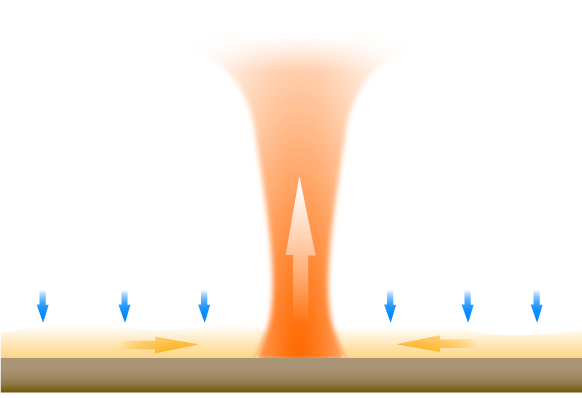
As air climbs up, it cools down. It occurs at some altitude that updraft cools down quicker than surrounding air. Air arrives at the top of the CBL (Convective Boundary Layer). Detrainment of thermal plumes warm up surrounding air and creates this uniform potential temperature layer which grow during a sunny day under the geostrophic layer. Potential temperature is not the ambient temperature of surrounding air. It is the temperature of an air particle compressed back to the standard temperature of 1000 hectopascals. As ambient air is at a pressure lower than 1000 hectopascals, compression warms it up. In altitude, potential temperature is always higher than ambient temperature. Potential temperature is very useful to interpret soundings since its gradient is directly related to atmosphere stability.
In mountains, thermal plumes tend to appear on ridges or summits, or along sunny cliffs. What about lowland regions? With verticalisation, we have seen that thermals are moving above the country. Is it possible that warm air feeding them starts from specific places?
Track analysis comes from the idea that pilots keep a constant diameter during circling at least for some period of time. Indeed one can observe that one circle is exactly superimposed with the former. Each pilot uses commonly two or three diameters according to circumstances. Segments of the track were circles superimpose exactly with previous ones after wind correction are called “giratoires”. Track segmentation during these giratoires, gives homogenous air particles whose speeds in the three directions can easily be calculated. A former chapter has given east and north speeds. We calculate vertical speed from the GPS altitude. To obtain the vertical air speed, one has to add sink rate of the paraglider during circling. Sink rate is related to circle diameter. Knowing pilot position and ground altitude, it is easy to calculate starting point of warm air as indicated on next figure :
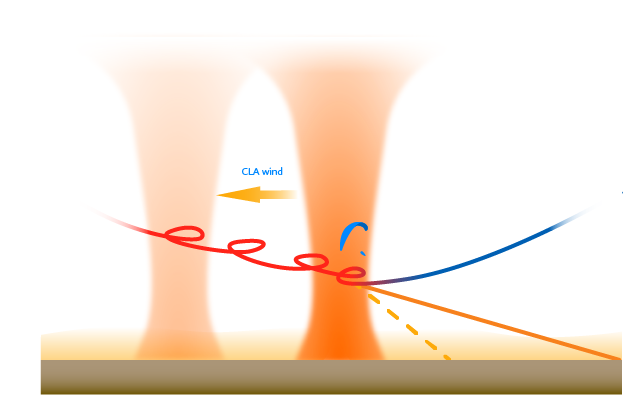
After his transition, the pilot begins to circle. He moves vertically in the CBL, but as CBL moves with the wind, the pilot moves obliquely above the ground (orange line). Warm air climbs faster than the pilot (yellow line). The difference between the two lines corresponds to the sink rate of the paraglider. Yellow line reaches the ground at the starting point of warm air. Next image shows the result for a thermal of may 9, 2017 over bassin parisien.
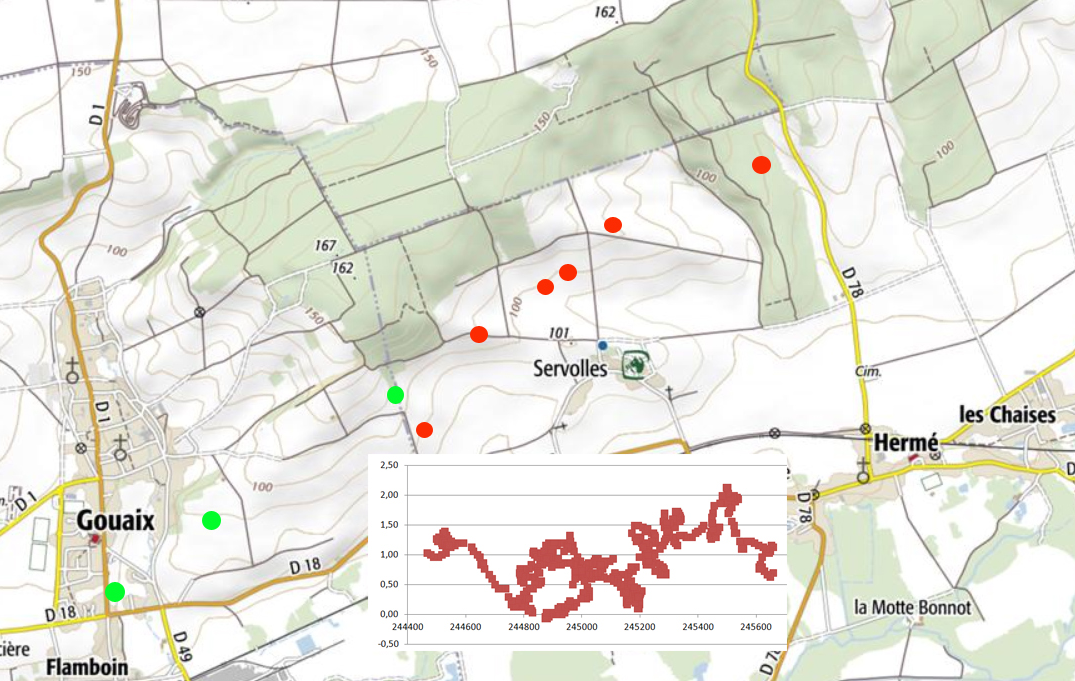
In that updraft, the pilot has circled six giratoires. Red points correspond to the starting points of warm air for the six giratoires. Due to uncertainties of parameters (wind, vario, sink rate) these red dots indicate the center of warm air areas feeding the giratoire. Green points give the corresponding position of the pilot. When warm air reaches the pilot, it left the ground well before and has been drifting a lot. The track on the ground follows a slope oriented SSE just under a woody plateau ledge. The track spreads along more than one kilometer. Green dots are farther toward SW. Nevertheless, in the CBL, warm air moves vertically under the pilot. Updraft and pilot are drifting together with the wind. The reason why the green points are spread to the SW, is also that the pilot has moved under the cloud, from giratoire to giratoire in a constantly ascending zone. For that updraft, warm air for the first giratoire starts from a small woody ridge oriented SE, for the second from a small cultivated ridge, third and fourth from a cultivated slope oriented SSE, fifth from a cultivated ESE ridge and sixth from a cultivated SE slope.
For some thermals, the potential lane of warm air origin can spread for many miles as the famous Azerable thermal of Martin Morlet record flight of may 1, 2016.
9 May 2017 flights
To get a statistical analysis of thermals starting zone, we explored the tracks of seven pilots which have been flying over bassin parisien starting from Chamery, a small village among Champagne vineyards in the south-west of Reims. Cumulated flight time for the seven pilots was 21 hours and cumulated distance 342 miles. Wind was north-east at 10 mph. At least until Montereau pilots headed south-west. At the beginning, they flew over the woody Montagne de Reims, but then appears a homogeneous landscape of crops and woods, plateaus and valleys, wide or narrow. Rivers level is about three hundred feet under plateaus. Around them, slopes are moderate. Steepest are woody, others are cultivated. In this area we have selected a rectangle which spreads between 3.1 and 4 degrees in longitude and between 48.235 and 49.1 degrees in latitude which represent 41 miles from east to west and 53 miles from north to south to check the starting points of all the giratoires.
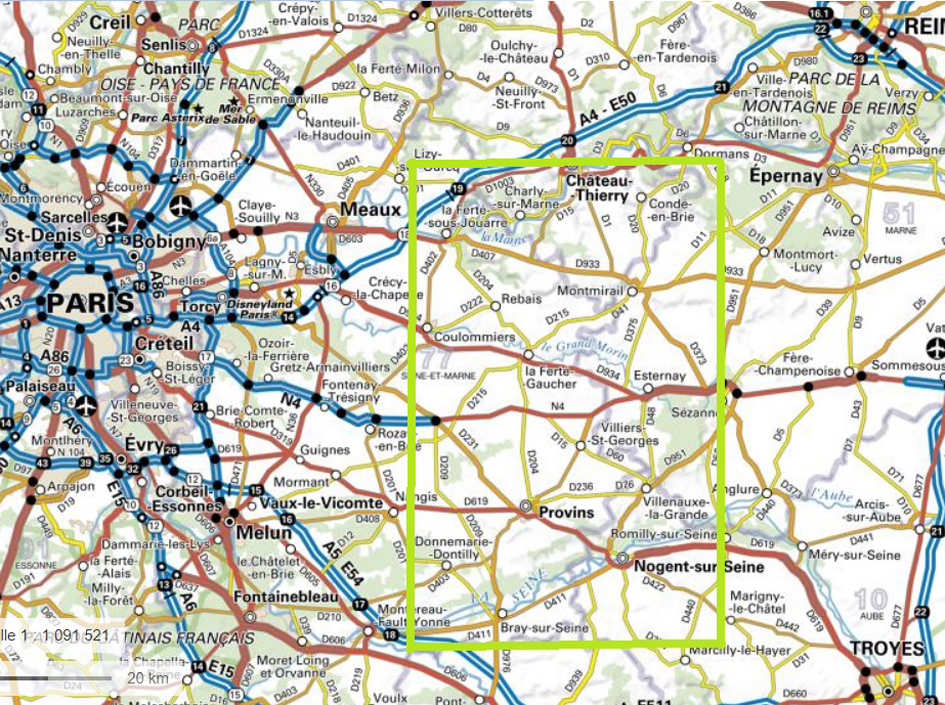
At first, we have made a statistical description of the landscape, selecting features potentially affecting warm air generation: relief, orientation of relief, ground nature. In the mountains, relief and orientation have a major influence on thermals position. On lowland, relief could keep some influence, but many pilots think that vegetation is the main parameter. On the surface of the rectangle, one applies a checkpoint every two minutes in longitude (about 1.5 mile) and every one and half a minute in latitude (about 1.8 mile). For each point, on the chart “géoportail” of Institut Géographique National, we have checked relief, orientation and vegetation. Then on that grid, we have selected a large lane corresponding to the flying zone of the pilots from Epernay to Montereau. We found 308 points among the 908 checked.
Relief
Statistical distribution of reliefs appears in the following image.
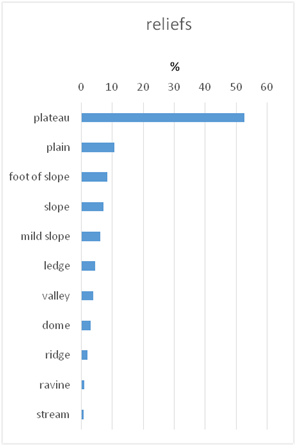
Obviously, the most frequent relief over la Brie is “plateau”. Together with “dome” and “stream” which are located on plateaus, we reach already 60% of inspected spots. Slopes are analyzed through four items: “ledge”, “slope”, “mild slope” and “foot of slope”. Slopes represent 26% of spots of which only 5% of slopes steeper than 25%. Steep slopes are mostly situated in the northern part of the domain. “Plains” are found on each side of main rivers: la Seine, la Marne, l’Yonne. Plains are often wet with numerous large “ponds”. The term “valley” is used for less important rivers or narrower plains like in the upper part of La Marne.
The 518 giratoires warm air starting spots have been analyzed under the same criteria and the next figure compares their frequency with the one of landscape spots.
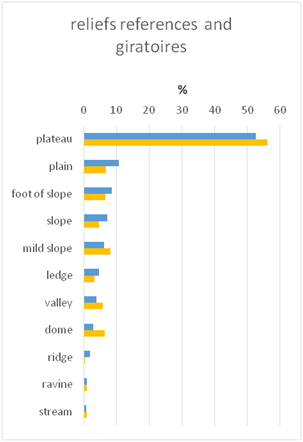
Distribution of warm air starting spots is almost the same as landscape distribution. Nevertheless, startups on “plateaus”, “domes” and “mild slopes” are slightly higher than in the landscape but the difference is minimal. The conclusion is that updrafts are poorly affected by this kind of relief.
Vegetation
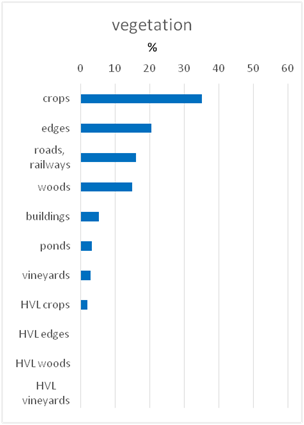
Crops represent 35% of surfaces considered and woods about 15%. Woods are rather scattered. There are few hedges but streams are often surrounded by trees. Consequently, with the lane of 100 yards on each side, item “edges” gathers hedges and wood edges and reaches 21% of spots. In the same way, “road” represents about 16%. No spot has been found on a town but the item “building” reaches 5%, items “pond” and “vineyard” 3% each.
Dispatching of warm air startups for vegetation is shown on the next figure with blue bars for landscape percentage and orange ones for startups.
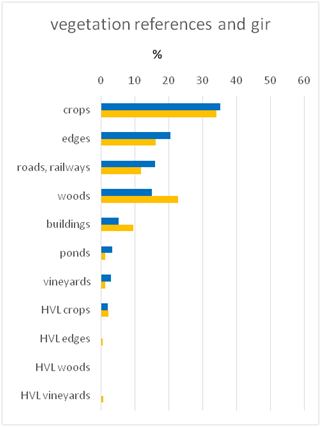
As for reliefs, there is no vegetation clearly privileged. Nevertheless, woods and buildings look more favorable than crops. Roads do not appear efficient nor HVL, but for this item, the limited number of occurrences weakens any conclusion.
Orientations
Slopes with their ledge and the curve connecting their lower part to the plain have a specific orientation. Streams or ravines and some ridges can also be oriented. On the 308 spots of landscape, 90 that are to say 29% can be given an orientation. For each line, orientation has been selected among the 16 directions of the compass. But a slope is rarely straight and may have several orientations and its evaluation falls more often on the main eight. Consequently, the results have been averaged on the main height. Next figure presents these orientations. One can notice that there are few west orientations. The reason is probably that the altitude of the entire zone is slowly declining from east to west.
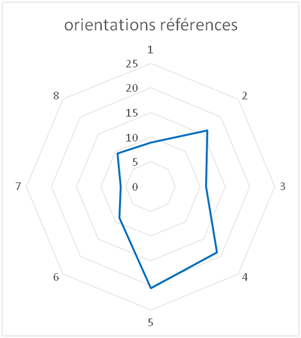
In the same way, among the 568 warm air starts, only 121 have an orientation that is to say 23%. This percentage, lower than that of landscape, would mean that flat lands are slightly more favorable for updrafts.
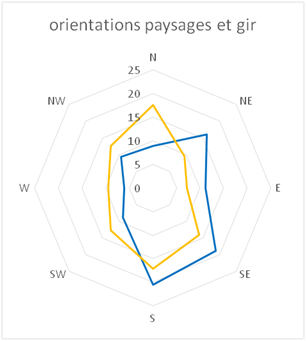
One can notice a limited elongation of the figure toward north and south, but altogether the loop is rather centered on origin. Thermals are not very sensitive to slope orientation.
Conclusion
The 9th of May 2017 flights bring interesting information about thermal plumes above the bassin parisien. First of all, thermals are mostly randomly scattered. Nevertheless, there is a significant tendency to have more thermals above plateaus than above valleys. That does not exclude to find warm air starts in the middle of a large valley and sometimes even above a large pond. There is also a trend to have more thermals above woods (oaks or beech) than over crops which is quite surprising. The number of points and the significant difference exclude a statistical bias. When the starting point is a slope, north or south orientations are slightly privileged, but in general there are more warm air starts on flat areas than on slopes.




